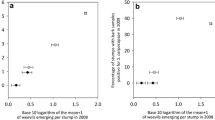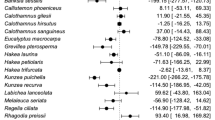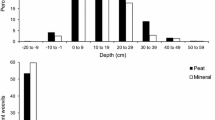Abstract
The invasive plant pathogen Phytophthora cinnamomi (Stramenopila, Oomycota) has been introduced into 15 of the 25 global biodiversity hotspots, threatening susceptible rare flora and degrading plant communities with severe consequences for fauna. We developed protocols to contain or eradicate P. cinnamomi from spot infestations in threatened ecosystems based on two assumptions: in the absence of living hosts, P. cinnamomi is a weakly competitive saprotroph; and in the ecosystems we treated, the transmission of the pathogen occurs mainly by root-to-root contact. At two P. cinnamomi-infested sites differing in climate and vegetation types, we applied increasingly robust treatments including vegetation (host) destruction, fungicides, fumigation and physical root barriers. P. cinnamomi was not recovered at three assessments of treated plots 6–9 months after treatments. Given the high rates of recovery of P. cinnamomi from untreated infested soil and the sampling frequency, the probability of failing to detect P. cinnamomi in treated soil was <0.0003. The methods described have application in containing large infestations, eradicating small infestations and protecting remnant populations of threatened species.



Similar content being viewed by others
References
Andjic V, Barber PA, Carnegie AJ, GEStJ Hardy, Wingfield MJ, Burgess TI (2007) Phylogenetic reassessment supports accommodation of Phaeophleospora and Colletogloeopsis from eucalypts in Kirramyces. Mycol Res 111:1184–1198
Balci Y, Halmschlager E (2003) Phytophthora species in oak ecosystems in Turkey and their association with declining oak trees. Plant Pathol 52:694–702
Balci Y, Balci J, Eggers WL, MacDonald WL, Juzwik J, Long RP, Gottschalk KW (2007) Phytophthora spp. associated with forest soils in eastern and north-central US oak ecosystems. Plant Dis 91:705–710
Barchietto T (1992) Physiological responses of Phytophthora citrophthora to a subinhibitory concentration of phosphonate. Pest Biochem Physiol 42:151–166
Barrett S (2003) Monitoring of aerial phosphite applications for the control of Phytophthora cinnamomi in the Albany district. In: McComb JA, Hardy G, Tommerup IC (ed) Phytophthora in forests and natural ecosystems, 2nd international IUFRO working party 7.02.09, Albany, Western Australia. Murdoch University Print, Perth, Western Australia, pp 132–137
Bergot ME, Cloppet V, Pérarnaud M, Deque M, Marcais B, Desprez-Loustou ML (2004) Simulation of potential range expansion of oak disease caused by Phytophthora cinnamomi under climate change. Global Change Biol 10:1539–1552
Brasier CM (1992) Oak tree mortality in Iberia. Nature 360:539
Brasier CM (1996) Phytophthora cinnamomi and oak decline in southern Europe. Environmental constraints including climate change. Ann Forest Sci 53:347–358
Cahill DM, Rookes JE, Wilson BA, Gibson L, McDougall KL (2008) Turner review no. 17. Phytophthora cinnamomi and Australia’s biodiversity: impacts, predictions and progress towards control. Aust J Bot 56:279–310
Chee HK, Newhook FJ (1965) Improved methods for use in studies on Phytophthora cinnamomi Rands and other Phytophthora species. NZ J Agric Res 8:88–95
Cooke DEL, Drenth A, Duncan JM, Wagels G, Brasier CM (2000) A molecular phylogeny of Phytophthora and related oomycetes. Fungal Genet Biol 30:17–32
Crandall BS, Gravatt GF, Ryan MM (1945) Root disease of Castanea species and some coniferous and broadleaf nursery stocks, caused by Phytophthora cinnamomi. Phytopathology 35:162–180
Daniel R, Guest D (2006) Defence responses induced by potassium phosphonate in Phytophthora palmivora-challenged Arabidopsis thaliana. Phys Mol Plant Pathol 67:194–201
Davison EM, Shearer BL (1989) Phytophthora spp. in indigenous forests in Australia. NZ J For Sci 19:277–289
Davison EM, Tay FCS (2005) How many soil samples are needed to show that Phytophthora is absent from sites in the south-west of Western Australia? Australas Plant Pathol 34:293–297
DEC (2006) Phytophthora dieback atlas: from the bush to your back fence: what you need to know. Department of Environment and Conservation, Perth, Western Australia. http://www.dec.wa.gov.au/land/dieback/managing-dieback/phytophthora-dieback-atlas.html
Dell B, Hardy G, Vear K (2005) History of Phytophthora cinnamomi management in Western Australia. In: Calver MC, Bigler-Cole H, Bolton G, Dargavel J, Gaynor A, Horwitz P, Mills J, Wardell-Johnson G (eds) A forest conscienceness: Proceedings of the 6th National Conference of the Australian Forest History Society. Millpress Science Publishers, Rotterdam, pp 391–406
Dobrowolski MP, Shearer BL, Colquhoun IJ, Hardy GES (2008) Selection for decreased sensitivity to phosphite in Phytophthora cinnamomi with prolonged use of fungicide. Plant Pathol 57:928–936
Duniway JM (1976) Movement of zoospores of Phytophthora cryptogea in soils of various textures and matric potentials. Phytopathology 66:877–884
EPPO (European Plant Protection Organisation) (2006) Distribution maps of quarantine pests for Europe. Phytophthora cinnamomi. European Plant Protection Organisation, Paris, France. Available from http://pqr.eppo.org/datas/PHYTCN.pdf (Accessed July 2008)
Erwin DC, Ribeiro IJ (1996) Phytophthora diseases worldwide. The American Phytopathological Society, St. Paul
Fichtner EJ, Lynch SC, Rizzo DM (2007) Detection, distribution, sporulation, and survival of Phytophthora ramorum in a California redwood-tanoak forest soil. Phytopathology 97:1366–1375
Garbelotto MD, Hüberli D, Shaw D (2006) First report on an infestation of Phytophthora cinnamomi in natural oak woodlands of California and its differential impact on two native oak species. Plant Dis 90:685
Garkaklis MJ, Calver MC, Wilson BA, Hardy GES (2004) Habitat alteration caused by introduced plant disease: a significant threat to the conservation of Australian forest fauna. In: Lunney D (ed) Conservation of Australia’s forest fauna. Royal Zoological Society of New South Wales, Mosman, pp 899–913
Hansen E (2008) Alien forest pathogens: Phytophthora species are changing world forests. Boreal Environ Res 13:33–41
Hardham AR (2005) Pathogen profile. Phytophthora cinnamomi. Mol Plant Pathol 6:589–604
Hardy GESJ, Barrett S, Shearer BL (2001) The future of phosphite as a fungicide to control the soilborne plant pathogen Phytophthora cinnamomi in natural ecosystems. Australas Plant Pathol 30:133–139
Hill TCJ, Tippett JT, Shearer BL (1994) Invasion of Bassendean dune Banksia woodland by Phytophthora cinnamomi. Aust J Bot 42:725–738
Hill TCJ, Tippett JT, Shearer BL (1995) Evaluation of three treatments for eradication of Phytophthora cinnamomi from deep, leached sands in southwest Australia. Plant Dis 79:122–127
Hüberli D, Tommerup IC, Hardy G (2000) False-negative isolations or absence of lesions may cause mis-diagnosis of diseased plants infected with Phytophthora cinnamomi. Australas Plant Pathol 29:164–169
Isbell RF (2002) The Australian soil classification. CSIRO Publishing, Collingwood
Malajczuk N (1983) Microbial antagonism to Phytophthora. In: Erwin DC, Bartnicki-Garcia S, Tsao PH (eds) Phytophthora: its biology, taxonomy, ecology, pathology. American Phytopathological Society, St. Paul, pp 197–218
Marks GC, Kassaby FY (1974) Detection of Phytophthora cinnamomi in soils. Aust Forest 36:198–203
Marks GC, Kassaby FY, Fagg PC (1975) Variation in population levels of Phytophthora cinnamomi in Eucalyptus forest soils of Eastern Victoria. Aust J Bot 23:435–449
McCarren KL, McComb JA, Shearer BL, Hardy GESJ (2005) The role of chlamydospores of Phytophthora cinnamomi—a review. Australas Plant Pathol 34:333–338
McDougall KL (1996) Vegetation patterns in the northern jarrah forest of Western Australia in relation to dieback history and the current distribution of Phytophthora cinnamomi. PhD thesis, Murdoch University
Myers N, Mittermeier RA, Mittermeier CG, da Fonseca GAB, Kent J (2000) Biodiversity hotspots for conservation priorities. Nature 403:853–858
Peel MC, Finlayson BL, McMahon TA (2007) Updated world map of the Köppen-Geiger climate classification. Hydrol Earth Syst Sci 11:1633–1644
Peters D, Weste G (1997) The impact of Phytophthora cinnamomi on six rare native tree and shrub species in the Brisbane Ranges, Victoria. Aust J Bot 45:975–995
Podger FD (1968) Aeteology of jarrah dieback. MSc thesis, University of Melbourne
Podger FD, Mummery DC, Palzer CR, Brown MJ (1990) Bioclimatic analysis of the distribution of damage to native plants in Tasmania by Phytophthora cinnamomi. Aust J Ecol 15:281–289
Reiter N, Weste G, Guest D (2004) The risk of extinction resulting from disease caused by Phytophthora cinnamomi to endangered, vulnerable or rare plant species endemic to the Grampians, western Victoria. Aust J Bot 52:425–433
Richardson DM, Pysek P, Rejmánek M, Barbour MG, Dane Panetta F, West CJ (2000) Naturalization and invasion of alien plants: concepts and definitions. Div Distrib 6:93–107
Ristaino JB, Gumpertz ML (2000) New frontiers in the study of dispersal and spatial analysis of epidemics caused by species in the genus Phytophthora. Ann Rev Phytopathol 38:541–576
Ruzo LO (2006) Physical, chemical and environmental properties of selected chemical alternatives for the pre-plant use of methyl bromide as soil fumigant. Pest Manag Sci 62:99–113
Sastry MNL, Hegde RK (1992) Soil percolation and efficacy of fungicides on the inoculum of Phytopphthora palmivora MF4, the incitant of black pepper wilt. Ind Phytopathol 45:71–73
Shea SR, Shearer BL, Tippett JT, Deegan PM (1983) Distribution, reproduction and movement of Phytophthora cinnamomi on sites highly conducive to jarrah dieback in south western Australia. Plant Dis 67:970–973
Shearer BL, Fairman RG (2007) Application of phosphite in a high-volume foliar spray delays and reduces the rate of mortality of four Banksia species infected with Phytophthora cinnamomi. Australas Plant Pathol 36:358–368
Shearer BL, Crane CE, Cochrane A (2004a) Quantification of the susceptibility of the native flora of the South-West Botanical Province, Western Australia, to Phytophthora cinnamomi. Aust J Bot 52:435–443
Shearer BL, Crane CE, Fairman RG (2004b) Phosphite reduces disease extension of a Phytophthora cinnamomi front in Banksia woodland, even after fire. Australas Plant Pathol 33:249–254
Shearer BL, Crane CE, Barrett S, Cochrane A (2007) Phytophthora cinnamomi invasion, a major threatening process to conservation of flora diversity in the South-west Botanical Province of Western Australia. Aust J Bot 55:225–238
Stamps DJ, Waterhouse GM, Newhook FJ, Hall GS (1990) Revised tabular key to the species of Phytophthora. Mycol Pap, No. 62
Swiecki TJ, Bernhardt EA, Garbelotto M (2003) First report of root and crown rot caused by Phytophthora cinnamomi affecting native stands of Arctostaphylos myrtifolia and A. viscida in California. Plant Dis 87:1395
Tainter FH, O’Brien JG, Hernandez F, Orozco F, Rebolledo O (2000) Phytophthora cinnamomi as a cause of oak mortality in the state of Colima, Mexico. Plant Dis 84:394–398
Tynan KM, Wilkinson CJ, Holmes M, Dell B, Colquhoun IJ, McComb JA, Hardy GESJ (2001) The long-term ability of phosphite to control Phytophthora cinnamomi in two native plant communities of Western Australia. Aust J Bot 49:761–770
von Broembsen SL, Kruger FJ (1985) Phytophthora cinnamomi associated with mortality of native vegetation in South Africa. Plant Dis 69:715–717
von Ende CN (2001) Repeated measures analysis: growth and other time-dependent measures. In: Scheiner SM, Gurevitch J (eds) Design and analysis of ecological experiments. Oxford University Press, Oxford, pp 116–157
Websdane KA, Sieler IM, Sivasithamparam K, Dixon KW (1994) Smut and root rots on native rushes (Restionaceae) and sedges (Cyperaceae). J Roy Soc West Aust 77:133–137
Weste G, Marks GC (1987) The biology of Phytophthora cinnamomi in Australasian forests. Ann Rev Phytopathol 25:207–229
Weste G, Vithanage K (1979) Survival of chlamydospores of Phytophthora cinnamomi in several non-sterile, host-free forest soils and gravels at different water potentials. Aust J Bot 27:1–9
Weste GM, Cooke D, Taylor PA (1973) The invasion of native forest by Phytophthora cinnamomi. II. Post-infection vegetation patterns, regeneration, decline in inoculum, and attempted control. Aust J Bot 21:13–29
White TJ, Bruns T, Lee S, Taylor J (1990) Amplification and direct sequencing of fungal ribosomal RNA genes for phylogenetics. In: CR P, Innis MA, Gelfand DH, Sninsky JJ, White TJ (eds) Protocols: a guide to methods, applications. Academic Press, San Diego, pp 315–321
Wilkinson CJ, Holmes JM, Tynan KM, Colquhoun IJ, McComb JA, Hardy GESJ, Dell B (2001) Ability of phosphite applied in a glasshouse trial to control Phytophthora cinnamomi in five plant species native to Western Australia. Australas Plant Pathol 30:343–351
Williams N, Hardy GESJ, O’Brien PA (2009) Analysis of the distribution of Phytophthora cinnamomi in soil at a disease site in Western Australia using nested PCR. For Pathol 39:95–109
Worthing CR, Walker SB (1983) The pesticide manual: a world compendium. British Crop Protection Council, 7th edition, p 252
Zentmyer GA (1980) Phytophthora cinnamomi and the diseases it causes. Monograph no. 10. The American Phytopathological Society, St. Paul, p 96
Zentmyer GA (1988) Origin and distribution of four species of Phytophthora. Trans Brit Mycol Soc 91:367–378
Zentmyer GA, Mircetich SM (1966) Saprophytism and persistence in soil by Phytophthora cinnamomi. Phytopathol 56:710–712
Zentmyer GA, Ohr HD (1978) Avocado root rot. Leaflet 2440. Division of Agricultural Sciences. University of California, Riverside, California, p 15
Acknowledgments
Funding was provided by the Department of Environment, Water, Heritage and the Arts (Commonwealth of Australia). We thank R. Armistead, B. Morrison, M. P. Dobrowolski, K. Howard, C. E. Crane, Y. Chen, and S. Barrett as principal contributors in the execution of field experiments. The Department of Environment and Conservation (Western Australia), and the Parks and Wildlife Service (Tasmania) gave material support. We thank, without implication, two anonymous reviewers for thorough and perceptive feedback on the first submission of this paper.
Author information
Authors and Affiliations
Corresponding author
Rights and permissions
About this article
Cite this article
Dunstan, W.A., Rudman, T., Shearer, B.L. et al. Containment and spot eradication of a highly destructive, invasive plant pathogen (Phytophthora cinnamomi) in natural ecosystems. Biol Invasions 12, 913–925 (2010). https://doi.org/10.1007/s10530-009-9512-6
Received:
Accepted:
Published:
Issue Date:
DOI: https://doi.org/10.1007/s10530-009-9512-6




